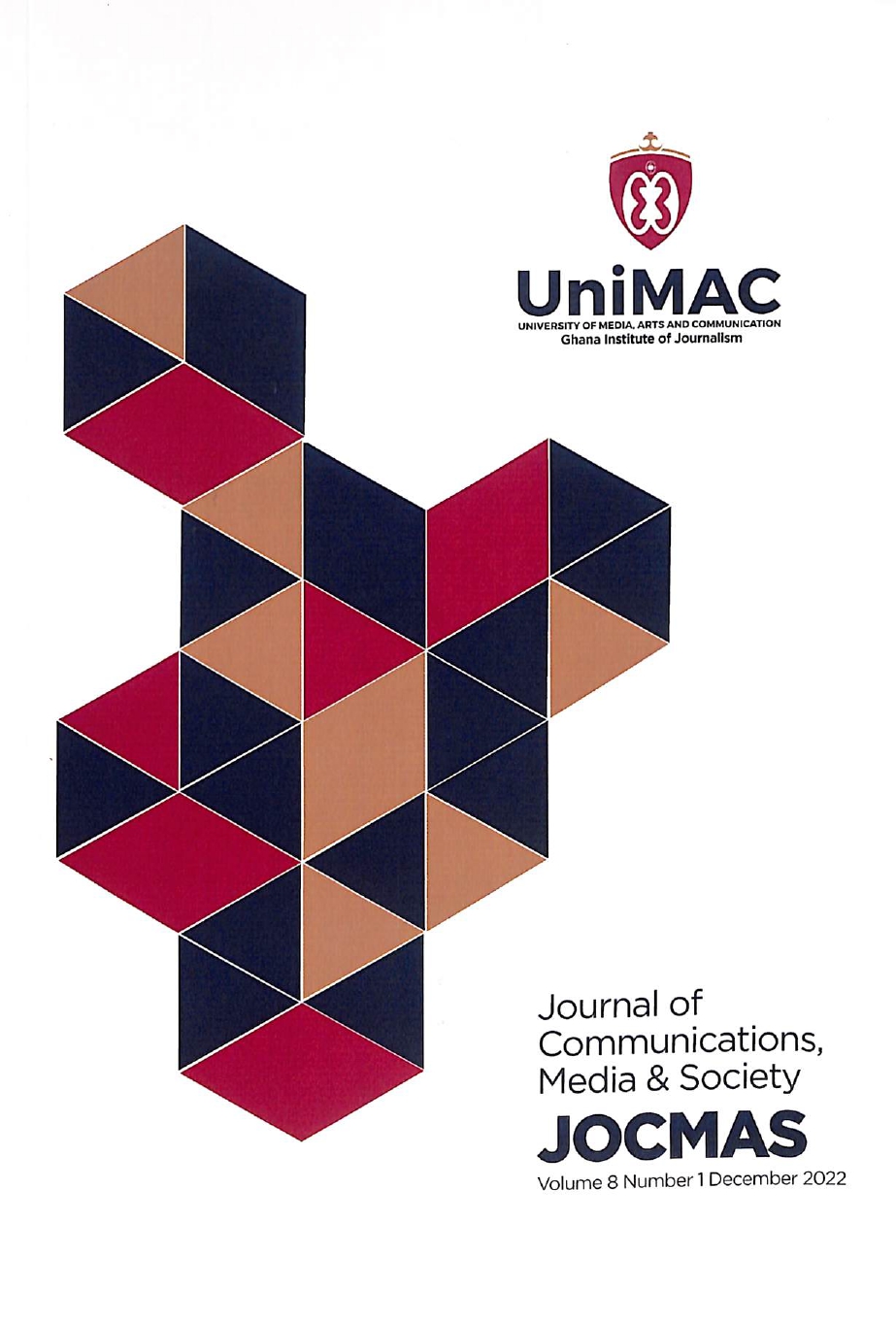Innovation in Media/Journalism Education and Research in Ghana
DOI:
https://doi.org/10.63772/jocmas.v3n1.4Keywords:
Innovation, Media, Journalism, Education, Research, GhanaAbstract
Rapid changes in the world today places a demand on journalism practice to take a new outlook that is underpinned by an innovative approach in its education and research. This study examined innovation in journalism education and research in Ghana. Qualitative approach to data collection and research was employed. Sample was selected using purposive and convenience sampling techniques. Sample consisted of journalism scholars and practitioners in tertiary educational institutions in Greater Accra region, Ghana. Data collected from the interview was analysed using thematic analysis. Key findings point to a disagreement in views regarding the gap between what is taught in the classroom and what is practised on the field. Journalism instructors were of the view that no such gap exists whereas the practitioners were of the opinion that a gap does exist. It is recommended that curriculum enrichment, teaching online journalism, organizing workshops and seminars for students, involving practitioners in curriculum development be promoted.
Downloads
Usage Statistics
- Abstract Views: 92
- PDF Downloads: 56
References
Bachovska, J., & Pandeva, I. R. (2012). The future of journalism education: Challenges and prospects. Iustinianus Primus Law Review, 3(5), 2–14.
Boafo, K. S. T. (1988). Journalism profession and training in sub-Saharan Africa: A case study of Ghana. Africa Media Review, 2(3), 56–74. African Council on Communication Education.
Business Recorder. (2011). Call for bridging the gap between theory and practice in journalism. Pakistan Press Foundations (PPF). Retrieved from https://pakistanpressfoundation.org
Carnegie Corporation of New York. (2005). Carnegie-Knight Initiative on the future of journalism education: Improving the education of tomorrow’s journalists (Executive summary). New York: Author.
Carpenter, H. (2012). Twenty five definitions of innovation. Spigit. Retrieved from https://www.spigit.com/blog/25-definitions-of-innovation
Chibita, B. M. (2009). Developing undergraduate journalism curricula: Concerns and issues. In R. Brand (Ed.), New journalism educators’ body: Tackling the challenge of teaching journalism in Africa (Conference proceedings, CAJE, p. 2). Retrieved from https://www.kas.de/wf/doc/kas_20767-1522-2-30.pdf
Curran, J. (2005). Foreword. In H. de Burgh (Ed.), Making journalists (pp. xi–xv). London: Routledge.
De Burgh, H. (Ed.). (2000). Investigative journalism. London: Routledge.
Da Rocha, I., Ramon, X., & Narberhaus, M. (2014). Literature and interviews on Spanish journalism education. Integrated Journalism in Europe.
Denzin, N. K., & Lincoln, Y. S. (1994). Handbook of qualitative research. Thousand Oaks, CA: Sage.
Deuze, M. (2006). Global journalism education. Journalism Studies, 7(1), 19–34. DOI: https://doi.org/10.1080/14616700500450293
Evans, R. (2014). Can universities make good journalists? Journal of the Association for Journalism Education, 3(1), 66–87.
Frawley, J., & Litchfield, A. (2009). Engaging students and academics in work-ready learning contextualized for each profession in the curriculum. In Proceedings of the 32nd HERDSA Annual Conference: The Student Experience (pp. 141–153). Darwin, Australia.
Fred, R. D., Meredith, E. D., & Foreit, R. D. (2011). What are business schools doing for business today? Business Horizons, 54, 51–62. Retrieved from https://www.sciencedirect.com DOI: https://doi.org/10.1016/j.bushor.2010.09.001
Grealish, L., & Trevitt, C. (2005). Developing a professional identity: Student nurses in the workplace. Contemporary Nurse, 19(1–2), 137–150. DOI: https://doi.org/10.5172/conu.19.1-2.137
Harold, P. (2001). Global development and the corporate food regime. In F. H. Buttel & P. McMichael (Eds.), New directions in the sociology of global development. Oxfordshire: Elsevier.
Hays, J. (2012). Wicked problem: Educating for complexity and wisdom. Paper presented at Wise Management in Organisational Complexity Conference, Shanghai, China, 23–24 May 2012.
Hays, J., & Clement, M. (2012). Transition bridging the gap between study and work. In Proceedings of the 9th International Conference on Cooperative and Work-Integrated Education, Istanbul, Turkey, 20–22 June 2012. World Association of Cooperative Education. Retrieved from https://www.waceinc.org/bahcesehir2012
Kuzel, A. J. (1999). Sampling in qualitative inquiry. In B. F. Crabtree & W. L. Miller (Eds.), Doing qualitative research (2nd ed., pp. 33–45). Thousand Oaks, CA: Sage.
Latham, B. (2007). Sampling: What is it? Quantitative Research Methods, ENGL 5377.
Lewitt, S. M., Snowden, A., & Sheward, L. (2014). Developing and sustaining a culture of innovation in health and higher education: Literature review. Council of Deans of Health, The Higher Education Academy.
McNair, B. (1998). The sociology of journalism. London: Arnold.
Mensing, D. (2011). Realigning journalism education. In B. Franklin (Ed.), Journalism education, training and employment (pp. 15–33). Oxford: Routledge.
Mensing, D. H., & Ryfe, D. M. (2013). Blueprint for change: From the teaching hospital to the entrepreneurial model of journalism education. International Symposium on Online Journalism, 2(2), 144–161.
Morse, J. M. (2000). Determining sample size. Qualitative Health Research, 10(1), 3–5. DOI: https://doi.org/10.1177/104973200129118183
Nieman Report. (2007). Teaching journalism in the digital age. The Nieman Foundation for Journalism at Harvard University, 61(3).
Newton, E. (2010). Journalism education’s four transformational trends. Retrieved from https://www.knightfoundation.org/blogs/knightblog/2010/8/4/aejmc
Newton, E. (2012, September 10). Journalism schools aren’t changing quickly enough. Retrieved from https://www.niemanlab.org/2012/09/eric-newton-journalism-schools-arent-changing-quickly-enough
Pearson, K. (2007). Start earlier. Expand the mission. Integrate technology. The Nieman Foundation for Journalism at Harvard University, 61(3).
Picard, G. R. (2014). Deficient tutelage: Challenges of contemporary journalism education. Toward 2020: New Directions in Journalism Education Conference, Ryerson University, Toronto.
Raybould, J., & Sheedy, V. (2005). Are graduates equipped with the right skills in the employability stakes? Industrial and Commercial Training, 37(5), 259–263. DOI: https://doi.org/10.1108/00197850510609694
Rosenstiel, T. (2013, April 17). Why we need a better conversation about the future of journalism education. Retrieved from https://www.poynter.org/latest-news/the-next-journalism/210196/why-we-need-a-better-conversation-about-the-future-of-journalism-education
Savage, S., Davis, R., & Miller, E. (2009). Exploring graduate transition from university to the workplace: Employer, academic and graduate perspectives. In Proceedings of the 24th AUBEA Conference: Managing Change—Challenges in Education and Construction for the 21st Century, Barossa Valley, Australia. Retrieved from https://eprints.qut.edu.au/20645/
Tveiten, O. (2010). Theorizing innovation journalism: Notes from the classroom. Innovation Journalism, 7(10).
Wood, L., & Kaczynski, D. (2007). University students in USA and Australia: Anticipation and reflection on the transition to work. International Journal of Employment Studies, 15(2), 91–106.
Downloads
Published
Issue
Section
License
Copyright (c) 2025 Journal of Communications, Media And Society (JOCMAS)

This work is licensed under a Creative Commons Attribution-NonCommercial 4.0 International License.








